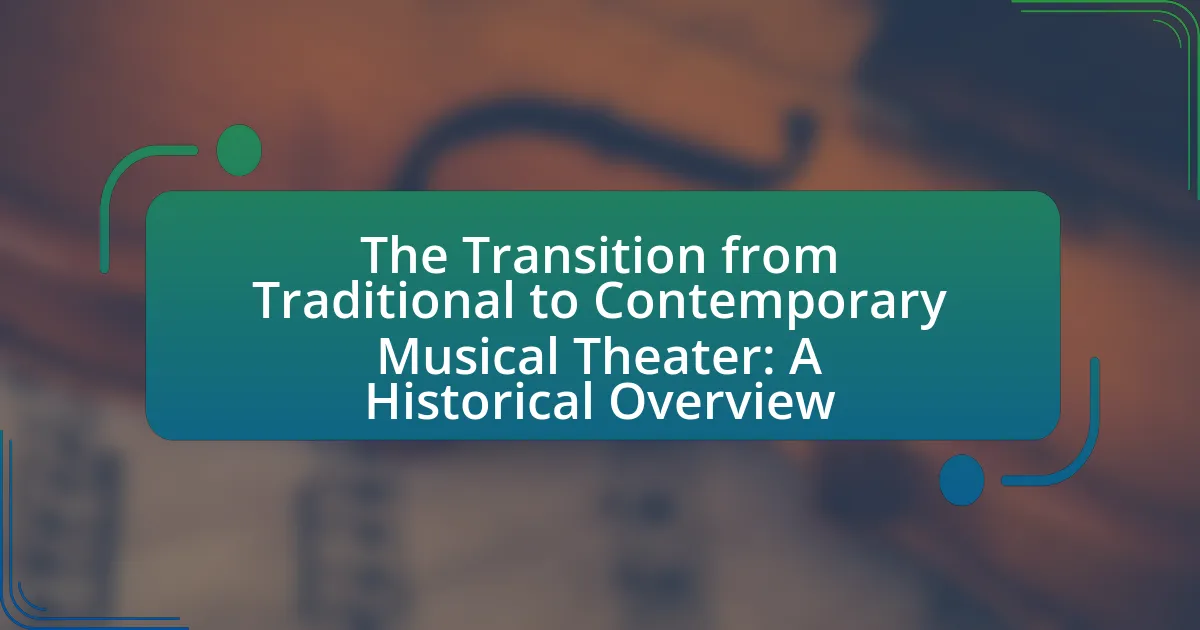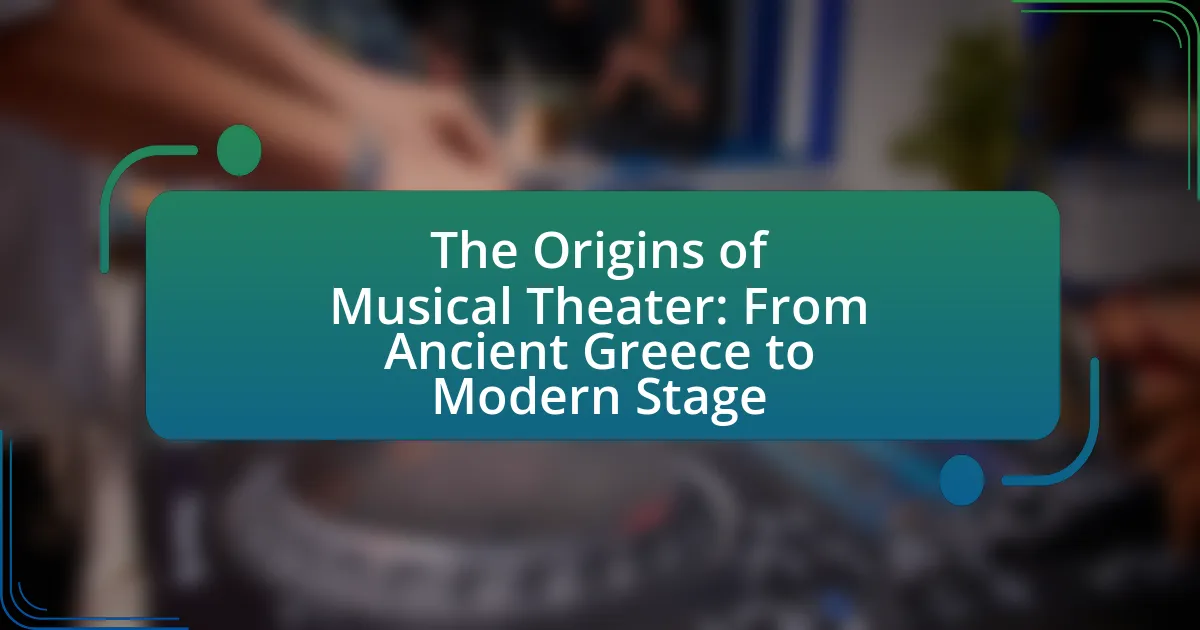The article examines the significant influence of World War II on American musical theater, highlighting how the war introduced themes of patriotism, resilience, and social change. It discusses the emergence of productions like “Oklahoma!” and “South Pacific,” which addressed complex issues such as love, sacrifice, and racial prejudice, reflecting the national mood during and after the war. The article also explores the impact of wartime experiences on musical composition, character portrayal, and production logistics, as well as the lasting legacies that shaped the evolution of American musical theater in the post-war era. Additionally, it analyzes audience responses and demographic shifts, emphasizing the role of musicals in boosting morale and addressing societal critiques during this transformative period.
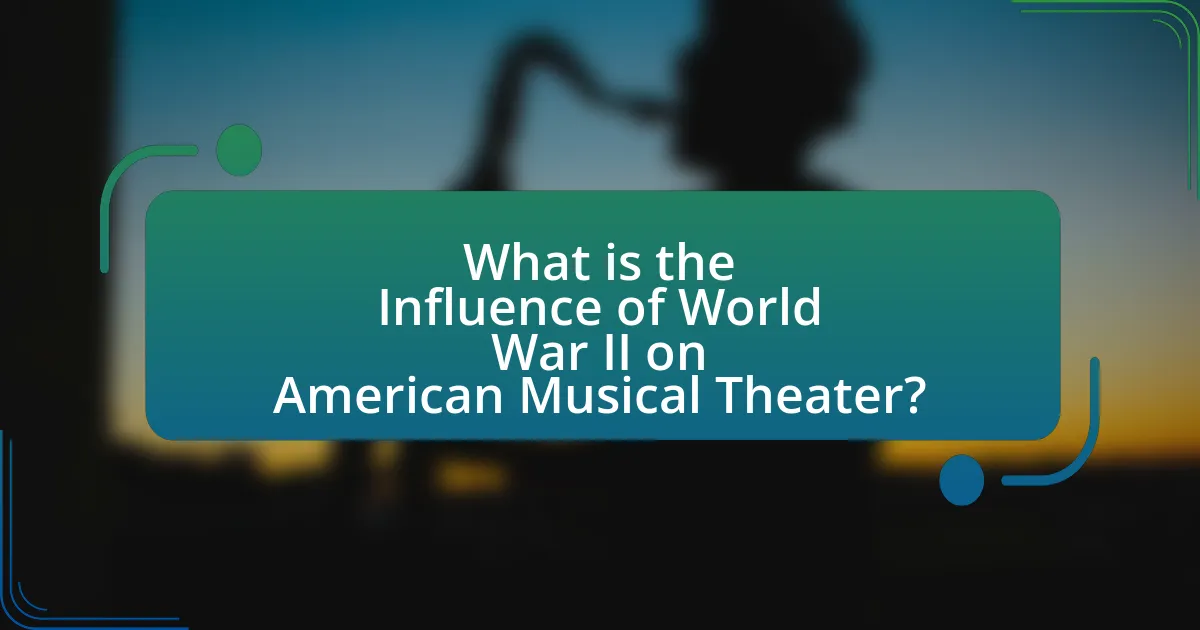
What is the Influence of World War II on American Musical Theater?
World War II significantly influenced American musical theater by introducing themes of patriotism, resilience, and social change. The war prompted a surge in productions that reflected the national mood, with shows like “Oklahoma!” (1943) and “South Pacific” (1949) addressing issues of love, sacrifice, and racial prejudice. These musicals not only entertained but also served as a means of coping with the war’s impact, fostering a sense of unity and hope among audiences. The era also saw the rise of composers and lyricists like Richard Rodgers and Oscar Hammerstein II, who revolutionized the genre by integrating complex narratives and character development into their works, thereby setting new standards for American musical theater.
How did World War II shape the themes in American Musical Theater?
World War II significantly shaped the themes in American Musical Theater by introducing narratives centered around patriotism, sacrifice, and the complexities of human relationships during times of conflict. The war prompted musicals to reflect the societal changes and emotional struggles faced by Americans, leading to productions that emphasized resilience and unity. For instance, shows like “Oklahoma!” and “South Pacific” explored themes of love and acceptance against the backdrop of war, highlighting the impact of military service and the fight against prejudice. Additionally, the wartime experience influenced the incorporation of more serious and mature themes, moving away from purely escapist entertainment to address real-world issues, as seen in “Cabaret” and “West Side Story.” These shifts in thematic focus were a direct response to the cultural and emotional landscape shaped by the war, illustrating how American Musical Theater evolved to resonate with the experiences of its audience during and after World War II.
What specific themes emerged in musicals during and after World War II?
Musicals during and after World War II prominently featured themes of patriotism, resilience, and the complexities of love in times of conflict. The war catalyzed a surge in narratives that celebrated national pride and unity, as seen in productions like “Oklahoma!” (1943), which emphasized community and hope. Additionally, the aftermath of the war introduced themes of disillusionment and the search for identity, reflected in shows such as “South Pacific” (1949), which tackled issues of racism and cultural conflict. These themes were shaped by the societal changes and emotional landscape of the era, highlighting the impact of the war on American life and values.
How did the war influence the portrayal of characters in musicals?
The war significantly influenced the portrayal of characters in musicals by introducing themes of resilience, sacrifice, and the complexities of human relationships during times of conflict. Musicals such as “South Pacific” and “Oklahoma!” reflected the realities of war, showcasing characters who grappled with love, loss, and moral dilemmas against the backdrop of World War II. For instance, “South Pacific” addressed racial prejudice and the impact of war on personal relationships, illustrating how characters navigated their identities in a time of societal upheaval. This shift in character portrayal was a direct response to the war’s emotional and social challenges, making the narratives more relatable and poignant for audiences experiencing similar struggles.
What changes occurred in musical styles due to World War II?
World War II significantly transformed musical styles, leading to the emergence of new genres and the evolution of existing ones. The war catalyzed a shift towards more diverse musical expressions, as composers and lyricists began to incorporate themes of struggle, resilience, and patriotism into their works. This period saw the rise of jazz and swing music, which became popular as a form of entertainment and escapism during the war. Additionally, the integration of various cultural influences, including Latin rhythms and blues, enriched American musical theater, resulting in a more eclectic sound. The wartime experience also prompted a focus on storytelling through music, with narratives reflecting the realities of war and its impact on society, as evidenced by productions like “Oklahoma!” which debuted in 1943 and showcased a blend of traditional musical elements with contemporary themes.
How did wartime experiences affect musical composition and lyrics?
Wartime experiences significantly influenced musical composition and lyrics by introducing themes of loss, sacrifice, and resilience. Composers and lyricists responded to the emotional landscape shaped by the war, often reflecting the struggles of soldiers and civilians alike. For instance, songs like “The White Cliffs of Dover” by Vera Lynn encapsulated hope amidst despair, while “Any Bonds Today?” by Frank Loesser encouraged patriotism and financial support for the war effort. These compositions not only served as morale boosters but also provided a means for people to process their experiences, illustrating the profound impact of World War II on American musical theater.
What new musical genres or styles were introduced during this period?
During the period influenced by World War II, new musical genres and styles such as jazz, swing, and the integration of folk elements into musical theater emerged. The war catalyzed a blending of musical influences, as soldiers and civilians alike were exposed to diverse sounds, leading to the popularization of jazz and swing in Broadway productions. Additionally, the incorporation of folk music reflected the cultural shifts and sentiments of the time, as seen in shows like “Oklahoma!” which premiered in 1943 and showcased a more narrative-driven style that combined traditional American folk elements with musical theater.
How did World War II impact the production and performance of musicals?
World War II significantly impacted the production and performance of musicals by altering themes, reducing available talent, and shifting audience expectations. The war led to a scarcity of male performers due to military enlistment, which forced productions to adapt by featuring more female leads and creating roles that resonated with wartime experiences. Additionally, musicals began to reflect the realities of the era, incorporating themes of patriotism, sacrifice, and resilience, as seen in works like “Oklahoma!” and “This Is the Army.” The economic constraints of the war also influenced production budgets, leading to more innovative staging and storytelling techniques. These changes not only shaped the content of musicals during the war but also laid the groundwork for the evolution of American musical theater in the post-war era.
What logistical challenges did theaters face during the war?
Theaters faced significant logistical challenges during the war, primarily due to resource shortages and restrictions on materials. The demand for war supplies led to a scarcity of essential items like fabric and metal, which impacted set and costume production. Additionally, many theater personnel were drafted into military service, resulting in a reduced workforce that strained operations. The wartime economy also caused fluctuations in ticket sales, as audiences were affected by rationing and the overall economic climate. These factors collectively hindered the ability of theaters to produce and stage performances effectively during World War II.
How did the war affect the availability of talent in the musical theater industry?
The war significantly reduced the availability of talent in the musical theater industry due to the enlistment of performers and creative professionals into military service. Many actors, musicians, and production staff were drafted or volunteered, leading to a shortage of skilled individuals necessary for productions. For instance, during World War II, it is estimated that over 16 million Americans served in the military, which included a substantial number of artists and entertainers. This depletion of talent forced theaters to rely on less experienced performers and adapt their productions, often resulting in a decline in the quality and quantity of shows being produced during that period.
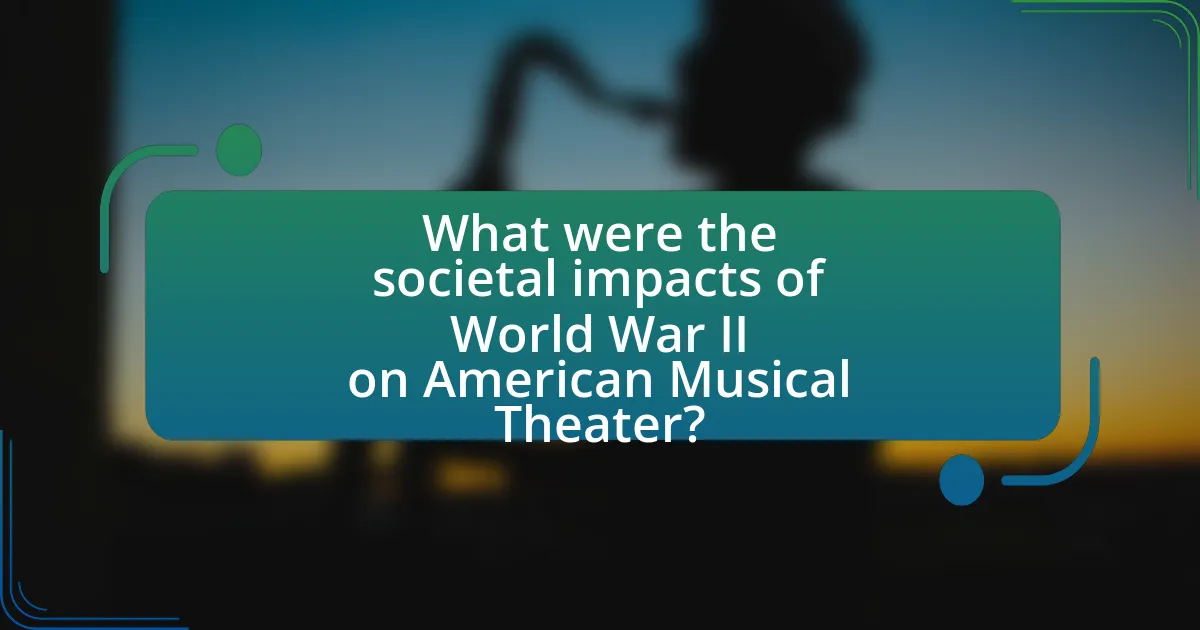
What were the societal impacts of World War II on American Musical Theater?
World War II significantly transformed American Musical Theater by introducing themes of patriotism, resilience, and social change. The war prompted a surge in productions that reflected the national mood, with shows like “Oklahoma!” and “South Pacific” addressing issues of identity and societal roles. Additionally, the war led to increased participation of women in theater, both on stage and behind the scenes, as many men were enlisted. This shift contributed to a broader acceptance of diverse narratives and characters, ultimately enriching the American musical landscape. The era also saw the rise of the “book musical,” which integrated songs and storytelling more cohesively, a change influenced by the need to convey complex emotions during wartime.
How did American audiences respond to musicals during and after the war?
American audiences responded positively to musicals during and after World War II, viewing them as a source of escapism and hope amidst the turmoil of war. The wartime period saw an increase in the popularity of musicals that featured uplifting themes and patriotic sentiments, such as “Oklahoma!” which premiered in 1943 and became a significant cultural touchstone. After the war, audiences continued to embrace musicals, as they provided a means to process the collective trauma and celebrate the return to normalcy, leading to the success of shows like “Carousel” in 1945. The resilience of American audiences was reflected in their support for productions that offered both entertainment and a sense of community during challenging times.
What role did musicals play in boosting morale during the war?
Musicals played a significant role in boosting morale during the war by providing entertainment that uplifted spirits and fostered a sense of community. During World War II, productions like “Oklahoma!” and “This Is the Army” not only entertained audiences but also conveyed messages of hope and resilience. These musicals often featured patriotic themes and showcased the sacrifices of soldiers, which resonated with both troops and civilians. The U.S. government recognized the importance of morale and supported musical productions, understanding that they could distract from the harsh realities of war and promote national unity. For instance, the War Department collaborated with Broadway to produce shows that entertained soldiers and raised funds for the war effort, demonstrating the direct impact of musicals on maintaining public spirit during challenging times.
How did audience demographics change in response to wartime themes?
Audience demographics shifted significantly during World War II, with increased attendance from women and younger audiences. As men were drafted into military service, women became the primary consumers of entertainment, leading to a rise in female attendance at musical theaters. Additionally, the war effort fostered a sense of community and patriotism, attracting younger audiences who sought escapism and morale-boosting content. According to a study by the American Theatre Wing, the percentage of women attending performances rose from 40% before the war to over 60% during the war years, illustrating this demographic shift.
What messages were conveyed through musicals in relation to the war?
Musicals during World War II conveyed messages of patriotism, resilience, and the human cost of war. Productions like “Oklahoma!” and “This Is the Army” emphasized national pride and unity, encouraging audiences to support the war effort. Additionally, musicals often highlighted the emotional struggles faced by soldiers and their families, as seen in “On the Town,” which depicted the fleeting joys of life amidst the backdrop of conflict. These themes resonated with audiences, reflecting the societal sentiments of the time and reinforcing the importance of hope and perseverance in the face of adversity.
How did musicals address issues of patriotism and sacrifice?
Musicals addressed issues of patriotism and sacrifice by incorporating themes that celebrated national pride and the sacrifices made by individuals during wartime. For instance, productions like “Oklahoma!” and “South Pacific” highlighted the importance of unity and the valor of soldiers, reflecting the societal sentiments of World War II. These musicals often featured characters who embodied the spirit of sacrifice, showcasing their struggles and triumphs in the face of adversity, which resonated with audiences experiencing the realities of war. The songs and narratives served as a means to bolster morale and foster a sense of collective identity, reinforcing the values of courage and dedication to the nation during a time of conflict.
What critiques of society were presented through wartime musicals?
Wartime musicals critiqued society by addressing themes of patriotism, social inequality, and the impact of war on everyday life. These productions often highlighted the disparity between the idealized image of American life and the harsh realities faced by soldiers and civilians alike. For instance, musicals like “This Is the Army” showcased the sacrifices made by service members while also exposing the struggles of those left behind, thereby critiquing the romanticized notion of war. Additionally, shows such as “On the Town” illustrated the challenges of urban life during wartime, emphasizing issues like racial segregation and economic hardship. These critiques were significant as they reflected the complexities of American society during World War II, prompting audiences to confront uncomfortable truths about their nation.
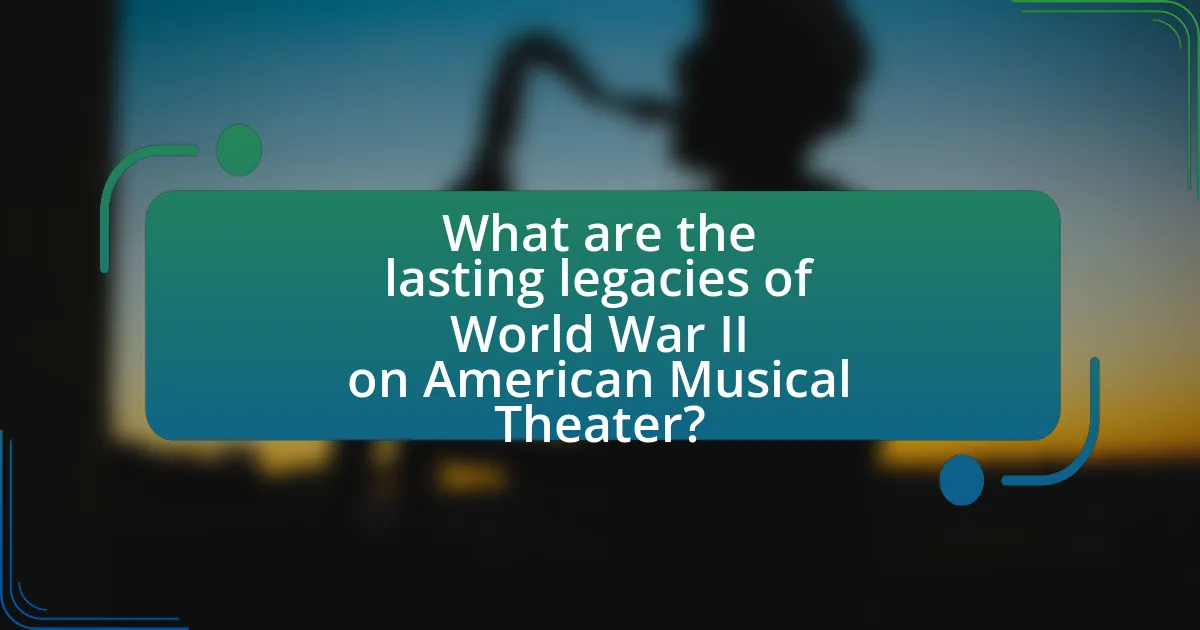
What are the lasting legacies of World War II on American Musical Theater?
The lasting legacies of World War II on American Musical Theater include the emergence of new themes, the incorporation of diverse musical styles, and the rise of a more complex narrative structure. Following the war, musicals began to reflect the societal changes and emotional complexities experienced by returning soldiers and civilians, leading to works that addressed issues such as trauma, identity, and social justice. For instance, shows like “South Pacific” (1949) tackled racial prejudice, while “West Side Story” (1957) explored urban conflict and cultural integration. Additionally, the influence of jazz and other musical genres expanded the soundscape of musicals, as composers like Leonard Bernstein and Stephen Sondheim integrated these styles into their works. The war also catalyzed a shift towards more sophisticated storytelling, moving away from traditional escapism to narratives that engaged with contemporary social issues, thereby reshaping the landscape of American Musical Theater for future generations.
How did the post-war era redefine American Musical Theater?
The post-war era redefined American Musical Theater by introducing more complex narratives and themes that reflected societal changes and the realities of modern life. This shift was marked by the emergence of groundbreaking works such as “Oklahoma!” in 1943, which integrated song and story more cohesively, and “West Side Story” in 1957, which tackled issues like racial tension and urban violence. These productions showcased a departure from the lighthearted escapism of earlier musicals, emphasizing character development and social commentary. The influence of World War II also led to a greater exploration of darker themes, as seen in shows that addressed the psychological impacts of war and the quest for identity in a rapidly changing world.
What influence did World War II have on the Golden Age of Musicals?
World War II significantly influenced the Golden Age of Musicals by shaping themes, styles, and the overall production landscape. The war led to a surge in patriotic sentiment and a desire for escapism, prompting musicals to incorporate uplifting narratives and heroic characters. For instance, shows like “Oklahoma!” (1943) and “South Pacific” (1949) reflected the complexities of love and conflict during wartime, resonating with audiences seeking solace and hope. Additionally, the war effort resulted in a shift in talent, as many artists served in the military, leading to a blend of traditional and innovative styles in musical theater. The economic conditions post-war also facilitated the growth of Broadway, as returning soldiers and a booming economy increased demand for entertainment, solidifying the Golden Age of Musicals as a defining era in American theater history.
How did the war set the stage for future musical innovations?
The war catalyzed future musical innovations by fostering a climate of experimentation and collaboration among artists. During World War II, the need for morale-boosting entertainment led to the creation of diverse musical styles that blended traditional forms with new influences, such as jazz and folk music. This period saw the emergence of groundbreaking works like “Oklahoma!” in 1943, which integrated song and dance into the narrative structure, setting a precedent for future musicals. The war also prompted the use of technology in music production, as advancements in sound recording and amplification became more prevalent, allowing for richer soundscapes in musical theater. These developments laid the groundwork for the evolution of American musical theater, influencing subsequent generations of composers and lyricists.
What lessons can contemporary musical theater learn from this period?
Contemporary musical theater can learn the importance of resilience and innovation from the period of World War II. During this time, American musical theater adapted to societal changes and challenges, reflecting the struggles and hopes of the era through storytelling and music. Productions like “Oklahoma!” and “South Pacific” addressed themes of unity and social issues, demonstrating how art can respond to and shape public sentiment. This adaptability and focus on relevant themes can guide contemporary creators in crafting works that resonate with today’s audiences, emphasizing the need for emotional connection and cultural relevance in storytelling.
How can modern productions reflect the historical context of World War II?
Modern productions can reflect the historical context of World War II by incorporating authentic narratives, period-specific music, and accurate representations of wartime experiences. For instance, musicals like “Memphis” and “The Band’s Visit” draw on themes of struggle and resilience that resonate with the societal impacts of the war. Additionally, the use of historically accurate costumes and set designs can immerse audiences in the era, while songs that echo the sentiments of the time, such as those addressing loss and hope, enhance the emotional connection to the historical context. Productions that include real-life stories or characters from the war, such as veterans or civilians affected by the conflict, provide a tangible link to the past, reinforcing the relevance of World War II in contemporary storytelling.
What best practices can be derived from the wartime musical theater experience?
Best practices derived from the wartime musical theater experience include the integration of strong narratives that resonate with audiences, the use of music and performance as a means of boosting morale, and the collaboration between diverse creative talents. During World War II, musicals often featured themes of resilience and patriotism, effectively engaging audiences and providing emotional support. For instance, productions like “Oklahoma!” and “This Is the Army” showcased how storytelling could unify and uplift communities during challenging times. Additionally, the collaboration between composers, lyricists, and performers was crucial, as seen in the works of Richard Rodgers and Oscar Hammerstein II, which set a precedent for teamwork in theater production. These practices highlight the importance of thematic relevance, emotional connection, and collaborative creativity in musical theater.



